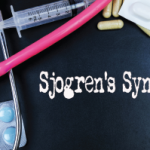Lesions may not point to multiple sclerosis (MS), and in fact, most brain lesions in Sjögren’s patients have different radiographic features than those associated with MS, said Dr. Birnbaum. “MS is very low on the differential diagnosis of white matter lesions in Sjögren’s syndrome patients,” he said. For example, MS scans may show Dawson’s fingers, which radiate outward from the ventricular surface, and prominent periventricular lesions. Brain lesions in Sjögren’s patients rarely show Dawson’s fingers and occur in a pattern with periventricular sparing lesions. In addition, inflammatory myelopathies may occur in Sjögren’s patients without brain lesions, he added.
Another possible demyelinating syndrome that can be distinguished from MS in Sjögren’s patients is Devic’s syndrome, or neuromyelitis optica (NMO). Spinal-cord lesions in NMO are considered a longitudinally extensive myelitis, due to the presence of inflammatory spinal-cord lesions spanning at least three vertebral segments on MRI studies, Dr. Birnbaum said. NMO-IgG antibody is a disease biomarker for this condition and targets aquaporin-4, which is the primary water-pump channel protein in the CNS. However, aquaporin-4 is also expressed in the salivary glands, lungs and kidneys, organs that are targeted in Sjögren’s syndrome patients.
“Sjögren’s patients may have a unique immunological predilection to develop these antibodies,” he said. The only unequivocal time to order immunosuppressant therapy in Sjögren’s syndrome with CNS manifestations is when a patient has Devic’s or another demyelinating syndrome other than MS, such as transverse myelitis, he said.
Other Neuropathies
Peripheral neuropathies are associated with specific antibody profiles in Sjögren’s syndrome, Dr. Birnbaum said. Whereas vasculitic neuropathies are associated with anti-Ro/SS-A antibodies and markers of B-cell activation, painful sensory neuropathies with normal electrodiagnostic studies may have lower frequencies of B-cell activation markers.
Neuropathic pain may be seen in about 20% of Sjögren’s patients, although only about 5–10% of patients in the literature show evidence of neuropathies. This disparity may be due to under-recognition of small-fiber neuropathies, painful conditions primarily affecting unmyelinated nerve fibers that require skin biopsy to diagnose, Dr. Birnbaum said. Patients with small-fiber neuropathies may complain of intense burning and allodynic pain. Two phenotypically distinct patterns of small-fiber neuropathy exist and can be distinguished based on the pattern of pain. Length-dependent, small-fiber neuropathies cause distal pain affecting the feet and distal extremities, and non-length-dependent, small-fiber neuropathies cause multifocal and diffuse burning pain, he said. A skin punch biopsy is not only a diagnostic biomarker of small-fiber neuropathies, but can help define these two patterns. In both subtypes of small-fiber neuropathies, aggressive symptomatic treatment of neuropathic pain is crucial, he said.

